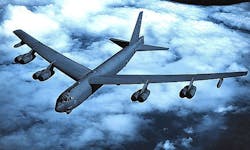Air Force approaches industry for power upgrades that enable B-52H bomber to carry MIL-STD-1760 weapons
These power upgrades would beef-up the firepower of the B-52H strategic bomber by enabling the aircraft to carry a wide variety of modern independently targeted smart weapons in its bomb bay and on underwing pylons, and give the B-52H the ability to attack several different targets in one pass.
The B-52 in different variants has been in the U.S. military's inventory since 1955. The eight-engine strategic bomber that was designed originally to carry nuclear weapons is expected to remain active with the Air Force through mid-century, and by the time it's retired may have been in the inventory for more than 100 years. The B-52H is designed to carry a variety of conventional weapons.
Officials of the Air Force Life Cycle Management Center (LCMC) at Tinker Air Force Base, Okla., have issued a request for information for the B-52H MIL-STD-1760 Internal Weapons Bay Upgrade (IWBU) Increment 1.2 project.
This program seeks to expand the ability to carry MIL-STD-1760 capable weapons inside the B-52H weapons bay on the common rotary launcher (CRL), including the AGM-158A/B Joint Air-to-Surface Standoff Missiles (JASSM), the AGM-158B/B extended-range JASSM (JASSM-ER), the ADM-160B Miniature Air Launched Decoys (MALD), and ADM-160C MALD-Jammer (MALD-J).
The 1760 IWBU Increment 1.2 program also includes extending MIL-STD-1760 capability to JASSM-ER missiles carried on pylons underneath the B-52H's wings. The MIL-STD-1760 aircraft/store electrical interconnection system defines a standardized electrical interface between a military aircraft and its weapons, sensors, and external fuel tanks.
The 1760 Increment 1.2 program seeks to modify the aircraft stores management overlays (SMO) for the aircraft to communicate with the munitions in the bomb bay and the wing pylons.
Communications with weapons should be interoperable with Combat Network Communication Technology (CONECT) and non-CONECT modified aircraft, and must be able to interoperate with the existing data transfer via the aircraft data bus, and must function the same way as weapons loaded on the wing pylon, Air Force officials say.
The project also will upgrade the B-52H Joint Mission Planning System (JMPS), modify aircraft power distribution, and modify power to the common rotary launcher.
JMPS updates should enable the individual targeting of weapons in the common rotary launcher loaded with a combination of eight JASSMs, JASSM-ERs, MALDS, or MALD-Js, as well as for two pylons on the B-52H with a maximum load. This would enable the B-52H to attack several different targets on one pass.
Power will route to weapons from the MIL-STD-1760 electrical interface via the generators in both of the B-52H wheel wells. The project calls for modifications to the aircraft's structure, common rotary launcher components, circuit breakers, and wire routing.
The low-rate initial production phase of the project will involve modifying as many as six aircraft with wiring and circuit breakers.
Contractors interested should email capability statements no later than 24 Jan. 2014 to the Air Force's Shelli Simmons at [email protected]. For questions or concerns contact Simmons at the same email address.
Those responding must have proprietary information agreements with Lockheed Martin, Raytheon, and Boeing for technical data interchange; in-depth knowledge of B-52H loading spectrum, aerodynamics, and modification procedures; and be ISO-9001 qualified for software development.
More information is online at https://www.fbo.gov/spg/USAF/AFMC/OCALCCC/B-52H/listing.html.
About the Author
John Keller
Editor-in-Chief
John Keller is the Editor-in-Chief, Military & Aerospace Electronics Magazine--provides extensive coverage and analysis of enabling electronics and optoelectronic technologies in military, space and commercial aviation applications. John has been a member of the Military & Aerospace Electronics staff since 1989 and chief editor since 1995.
